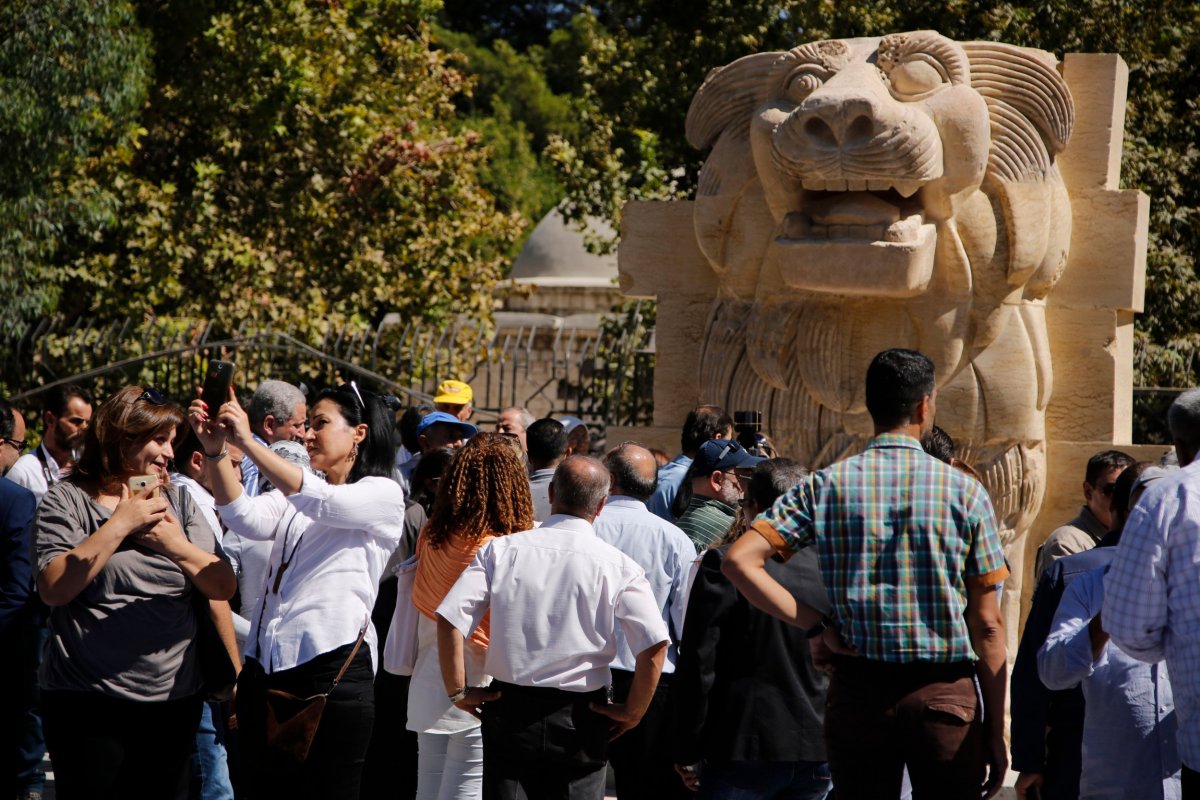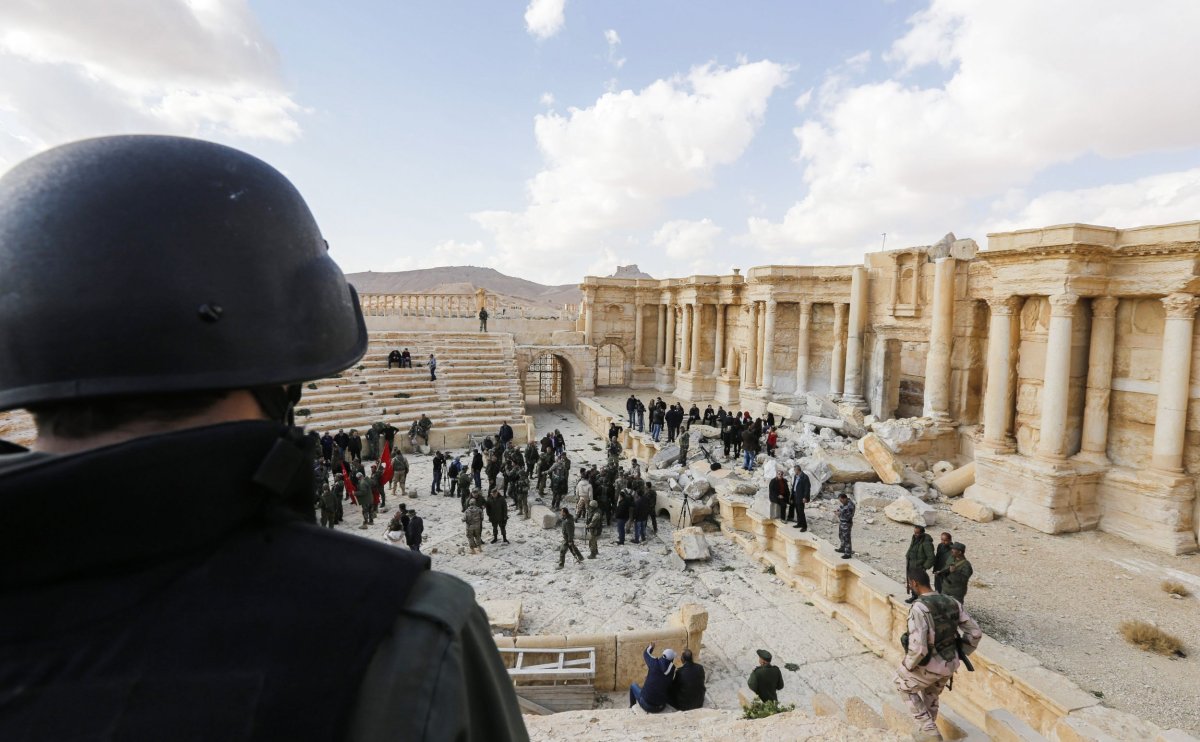
Restoration has been completed on a 2,000-year-old statue destroyed by the Islamic State militant group (ISIS) after the iconoclastic jihadists overran the ancient Syrian city of Palmyra in 2015.
The Lion of al-Lat, which stands 11 feet tall and weighs about 15 tons, was discovered by Polish archaeologists in 1977. It depicts a lion embracing a small gazelle and is believed to represent peace, but it ended up the target of one of Syria's most violent campaigns as ISIS twice swarmed Palmyra, demolishing many of its prized historic sites before the Syrian military ultimately ousted the group in March.
Related: ISIS claims Syria bombings after questionable links to Las Vegas and France attacks
"They destroyed the Lion of al-Lat statue during their entry into Palmyra with heavy bulldozers. When the Syrian Arab Army cleared the city of their desecration, the Directorate of Antiquities transferred the fragments of this huge statue to the National Museum in Damascus with help from Polish experts who discovered the statue in 1977 and restored it in coordination with local experts," newly appointed Director of Antiquities and Museums Mahmoud Hammoud said Sunday, according to the state-run Syrian Arab News Agency (SANA).
"Now it's ready to welcome visitors as a sign of reconstruction and the beginning of victory," he added.

Hammoud, who was appointed to his position Wednesday by Syrian Prime Minister Imad Khamis, condemned ISIS's attempts to erase Syria's pre-Islamic cultural heritage and pledged to work with international organizations, including UNESCO, to restore what was left of the country's historic sites.
Polish archaeologist Bartosz Markowski, who spent around two months restoring the Lion of al-Lat this year and previously worked on it in 2005 as well, also hailed the effort. He reportedly said Sunday that experts were able to recover about half of the iconic original statue, which is made of limestone.
"It is an exceptional statue, there are no more such statues in Palmyra," Markoswki said, according to Reuters.
"It was an internationally known symbol of Palmyra, it was standing in front of the museum. Every tourist visiting Palmyra and the museum had a photo with it," he added.
ISIS originated in a 2006 jihadist merger that included Al-Qaeda in Iraq, and later spread to neighboring Syria in 2013, about two years after demonstrations against Syrian President Bashar al-Assad (whose surname is one of 30 words in Arabic to mean "lion") descended into a war between the Syrian military, rebel groups and jihadists, among other factions. ISIS overcame rival insurgents and established a powerful foothold across the country, first taking the central city of Palmyra in May 2015.
ISIS's seizure of Palmyra was followed by mass executions and the destruction of iconic sites such as the tombs of Elahbel and Atenatan, the Arch of Triumph and the Temple of Baalshamin, and extensive damage to many more, including the Lion of al-Lat. Khaled al-Assad, the 81-year-old director of Palmyra's historic sites, refused to abandon the city and its works and was ultimately beheaded by ISIS in August 2015.

The Syrian military, supported by Russian airstrikes and Iran-backed militias, retook the city in March 2016, but lost it again later that year, in December, when troops were focused on retaking Syria's former commercial hub of Aleppo from rebels in the northwest. During this period, ISIS destroyed part of the famous Roman amphitheater and the cubic Tetrapylon.
Syrian troops and their allies retook Palmyra once again in March of this year, nearly a year after they retook it in 2016 and six years after the war began. The site has been cautiously reopened to journalists, musicians and select visitors, but the Syrian military's new focus on securing the ISIS-held eastern city of Deir Ezzor has allowed jihadists to creep through Syrian defense lines toward Palmyra once again. ISIS recently captured the town of Al-Qaryatayn, located some 200 miles within Syrian government territory, according to the Syrian Observatory for Human Rights, a U.K.-based monitor with ties to Syria's exiled opposition.
Until ISIS is defeated once and for all, the Lion of al-Lat is reportedly set to remain in the National Museum in Damascus, a city that is bastion of relative stability save for its restive suburbs that were only recently retaken by government forces. The statue, located near a temple dedicated to the pre-Islamic goddess Al-Lat, was believed to have rewarded those who shunned violence.
"Blessed are those who do not shed blood in the sanctuary of the temple," an inscription on the statue's left paw reads, according to SANA.
Uncommon Knowledge
Newsweek is committed to challenging conventional wisdom and finding connections in the search for common ground.
Newsweek is committed to challenging conventional wisdom and finding connections in the search for common ground.
About the writer
Based in his hometown of Staten Island, New York City, Tom O'Connor is an award-winning Senior Writer of Foreign Policy ... Read more
To read how Newsweek uses AI as a newsroom tool, Click here.








